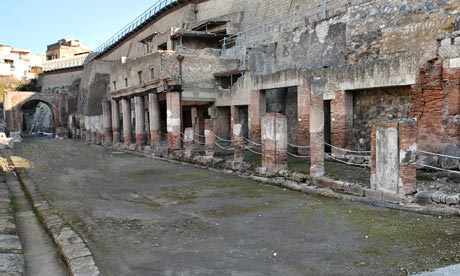from the Guardian............................
Roman high street reopens to visitors after more than 20 yearsDecumanus Maximus at Herculaneum, near Naples was preserved by eruption of Vesuvius in AD79
Share282 John Hooper in Rome guardian.co.uk, Tuesday 19 April 2011 19.38 BST Article history
The Roman high street, Decumanus Maximus, at Herculaneum, has been closed to visitors for more than 20 years.
The archaeologist Andrew Wallace-Hadrill calls it "one of those places where you step into a time machine" – the high street of a town that disappeared 1,932 years ago under ash and mud 20 metres deep.
At one end of the Decumanus Maximus at Herculaneum, near Naples, is a triumphal arch. Along its length stand archaeological treasures such as the House of the Double Porticos which retains original, though carbonised, wooden beams and shutters.
For more than 20 years the Decumanus Maximus has been closed to visitors. But at a ceremony at the site it was returned to the public.
"Most of Herculaneum as experienced by tourists consists of little narrow streets where people could virtually lean across from balcony to balcony and touch hands," Wallace-Hadrill said. "But the Decumanus Maximus is a big public space. It's impressive."
Its reopening marks the latest stage in the steady recovery and restoration of a settlement less well-known but in some respects more fascinating than Pompeii. Both were preserved by the eruption of Vesuvius in AD79.
Herculaneum was rediscovered by chance in the early 18th century. By 2001, when the Herculaneum Conservation Project (HCP) was launched, the partially excavated site was in a pitiful condition: two-thirds of its area was closed to visitors for reasons of either safety or conservation.
By the end of next year the HCP hopes to have reduced that proportion by half. The project has consolidated the escarpment that towers over the town, stabilised all but a handful of the ancient buildings, repaired most of the existing roofing and reinstated the original Roman drainage system, providing an outlet for water that once accumulated on the site and threatened to destroy it.
The contrast with developments at Pompeii, where part of a 2,000 year-old house fell down last year, could scarcely be starker.
The HCP was set up by a US non-profit foundation, the Packard Humanities Institute, and also involves the local office of Italy's heritage ministry and the British School at Rome. Wallace-Hadrill, the project's director, said its success is largely due to an emphasis on unglamorous maintenance, inter-disciplinary co-ordination and "low-cost, sustainable, practical solutions".
"The miracle of [David W] Packard's sponsorship is his willingness to fund the mundane", he said. This has led to some exciting archaeological discoveries.
Searching for the outlet of the drainage system, his team happened upon a magnificently decorated ceiling, with all the Roman craftsmanship still intact, and what Wallace-Hadrill called an "unspeakable amount of human waste which has given us a fascinating insight into the ancient Roman diet".

The Roman high street, Decumanus Maximus, at Herculaneum, has been closed to visitors for more than 20 years.
